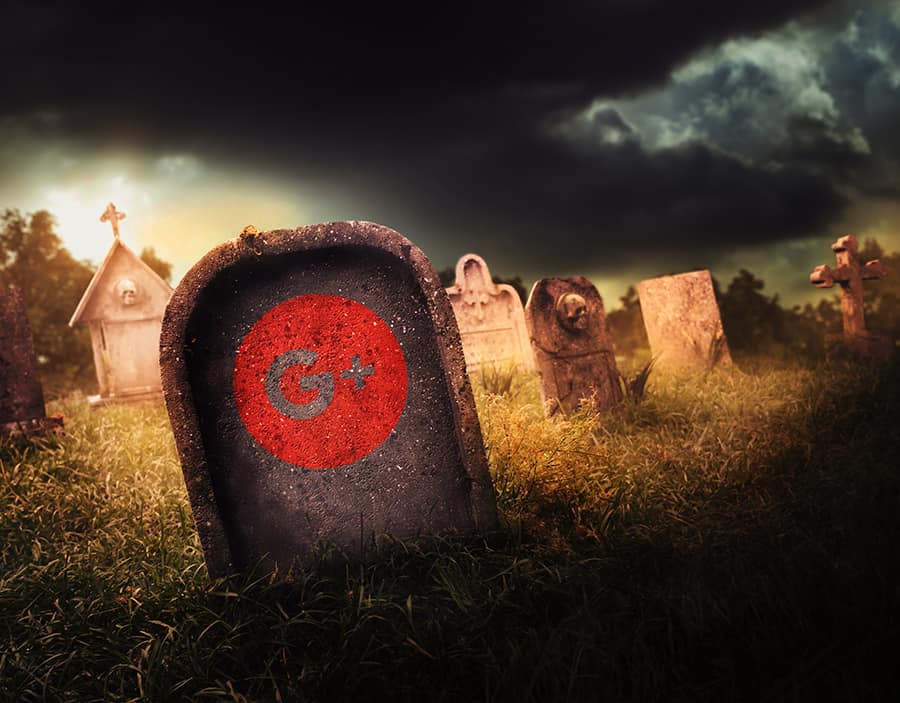
Above: Google+ comes to an end. Base image by fergregory/DepositPhotos.
BitDepth#1167 for October 18, 2018
Last week Google announced that it would be shutting down the consumer version of its Google+ social network by August 2019. The company will continue to develop Google+ Enterprise, a business facing collaboration tool that will be integrated into GSuite, it’s enterprise networking software.
As a cheerful BTW, Google also revealed that it had discovered a design flaw in its code that potentially exposed private user data but found no evidence that profile data had been misused.
But the real killer was the company’s acknowledgement of low user engagement and the difficulty of “creating and maintaining a successful Google+ that meets consumers’ expectations.”
In a particularly humiliating bit of data, Google noted that 90 percent of user sessions on the service last under five seconds.
For a company that ranks websites based on their bounce rate, which is the length of time that people spend on a page doing nothing before leaving, that’s a staggering admission.
That hard statistic measures how sticky the service is for its users (Facebook averages hours per user) and by that evaluation, Google managed to create a Teflon social platform.
Google+ is the company’s fourth attempt at creating a social network, and this failure follows the internment of Orkut (2004-2014), Google Friend Connect (2008-2012) and Google Buzz (2010-2011).
Why did Google+ fail so completely?
Some of the blame falls on Google itself, who never seemed to be sure exactly what the social network was supposed to be, what service it was supposed to deliver and who it was supposed to engage.
Most Google+ signups appear to have been the result of the company’s decision to change its approach from a social network to a “social layer” for all its services, so a Google+ sign-up was part of getting somewhere else entirely.
The greatest successes the service appears to have had is with people who were looking to build an audience for a passion project or service.
I once read a whole book on Google+ dedicated to how photographers could build communities using the social network, and for some, foodies and other special interests, it worked very well.
There was certainly no shortage of web-based services available to users of Google+ who could make use of the company’s productivity apps, powerful email, search, the video business YouTube and Hangouts, a popular virtual meeting app for small groups.
Two useful services, Google Photos and Hangouts were hived off Google+ to become separate services and the exclusivity of useful tools on the social network began to evaporate.
I’ve pushed story snippets and links to Google+ for years now with scant response. When the Cambridge Analytica bacchanal began, I expected people cautious about Facebook privacy concerns to begin using Google+.
They did not.
The spike in non-Facebook engagement with my reporting came from LinkedIn, which encouraged more posts and conversations from business focused and older readers.
The only surprise in the shuttering of Google+ for consumers is how long it took. Google isn’t normally very shy about declaring an app or service a bust and moving on, but Google+ lingered longer than anyone might have expected.
Google+ tried to be too many things, using metaphors that were different from perceived reality and inspired by a digital representation of the real world.
Circles and Ripples probably make a whole lot of sense on a whiteboard, but Google’s wonks seem to have missed the whole point of a social network or even a social layer, whatever that is.
People join a social network for the same time they hangout at the club or accompany a friend to a houseparty, for a chance to have fun and meet cool people.
In the end, the mortal Google+ error with consumers, it’s virtual seppuku, was that it felt like work while pretending to be fun.
The big negatives of Google+
-
Confusing metaphors. Facebook had a lock on “friends,” and the Google+ response, Circles, meant nothing outside of the rooms it was hatched up in.
-
Unclear interface. You never quite seemed to know where you were in Google’s social network. The hierarchy of the user experience seemed to branch and circle whimsically.
-
Unfocused market. A social network for “everyone” turns out to be a social network for nobody. People sign up for a service expecting a specific experience or for a specific purpose.
-
A sprawling canvas. Google built a huge digital platform but seemed unable to design spaces for particular pursuits or projects. Perhaps used to savvy customers who cobbled together useful systems from its online tools, the company must have assumed that Google+ users would do the same. It turns out that was too much work.
-
Lazy marketing. When Facebook was embroiled in Cambridge Analytica bacchanal and looked weak for the first time, Google did exactly nothing to position Google+ as a secure alternative. It might not have been persuasive as an agent of privacy, but it didn’t even bother to try.
-
No champions. People who were successful at building communities on Google+ (and yes, they existed) were invisible outside of their audience. Google did nothing to encourage evangelism or to lionise its success stories.
-
Uncertain premise. People go to Facebook to catch up with or meet new friends. They go to LinkedIn to raise their business profile. They post to Instagram to post photos, mostly of their fantasy lives. Google never created or articulated a good reason to use their social network.


